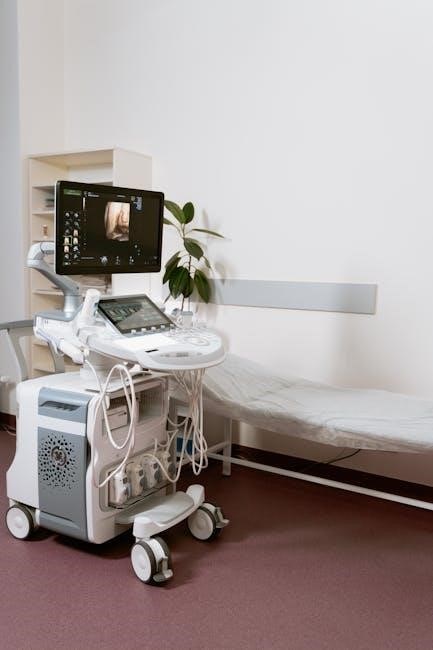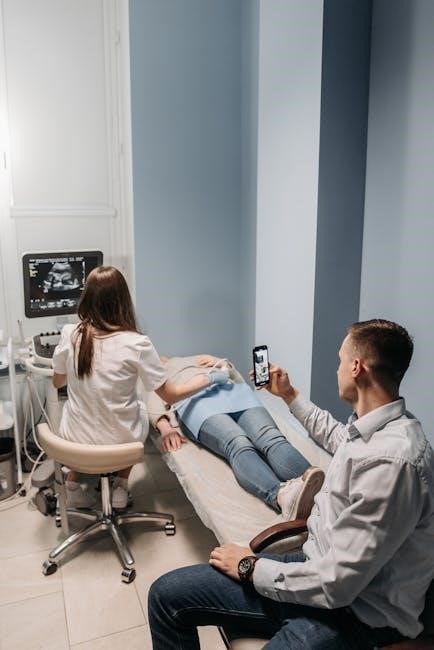Ultrasound guided cystocentesis is a veterinary procedure using ultrasound machines.
Definition and Purpose
The definition of ultrasound guided cystocentesis is a medical procedure that uses ultrasound technology to guide the insertion of a needle into the urinary bladder to collect urine samples.
This procedure is commonly used in veterinary medicine to diagnose and treat various urinary tract diseases and disorders.
The purpose of ultrasound guided cystocentesis is to provide a safe and accurate method for collecting urine samples, especially in patients with small or nonpalpable bladders.
The use of ultrasound guided cystocentesis has become increasingly popular in veterinary medicine due to its ability to reduce the risk of complications and improve the accuracy of urine collection.
The procedure involves the use of an ultrasound machine to visualize the urinary bladder and guide the insertion of the needle.
This allows for a more precise and controlled collection of urine samples, which is essential for accurate diagnosis and treatment.
Overall, the definition and purpose of ultrasound guided cystocentesis is to provide a safe and effective method for collecting urine samples in veterinary patients.
Importance in Veterinary Medicine
Ultrasound guided cystocentesis plays a crucial role in veterinary medicine as it enables the collection of urine samples from animals with ease and accuracy.
The procedure is particularly important for diagnosing and treating urinary tract infections, kidney diseases, and other related conditions.
Veterinarians rely on ultrasound guided cystocentesis to obtain high-quality urine samples, which are essential for laboratory tests and diagnostic procedures;
The importance of ultrasound guided cystocentesis in veterinary medicine cannot be overstated, as it helps to improve patient outcomes and reduce the risk of complications.
By using ultrasound technology, veterinarians can minimize the risk of injury to surrounding tissues and organs, making the procedure safer for animals.
Overall, ultrasound guided cystocentesis is a valuable tool in veterinary medicine, allowing for accurate and efficient diagnosis and treatment of urinary tract diseases.
Its importance is recognized by veterinarians worldwide, and it continues to be a vital component of veterinary care.

Indications for Ultrasound Guided Cystocentesis
Ultrasound guided cystocentesis is indicated for patients with specific conditions.
Small or Nonpalpable Bladder
Ultrasound guided cystocentesis is particularly useful in patients with small or nonpalpable bladders, as it allows for accurate visualization of the bladder and surrounding structures. This is especially important in cases where traditional palpation methods may be difficult or impossible. The use of ultrasound guidance enables veterinary professionals to locate the bladder and insert the needle with precision, reducing the risk of complications. In addition, ultrasound guided cystocentesis can be performed in patients with a variety of bladder sizes and shapes, making it a versatile and valuable tool in veterinary medicine. The procedure can be performed in dorsal or lateral recumbency, and the ultrasound machine provides real-time imaging of the bladder and surrounding tissues. This enables veterinary professionals to adjust the needle placement and avoid potential complications. Overall, ultrasound guided cystocentesis is a valuable technique for collecting urine samples in patients with small or nonpalpable bladders.
Difficulty in Urine Collection
Ultrasound guided cystocentesis is often used when there is difficulty in collecting urine samples using traditional methods. The procedure allows for the collection of a urine sample while minimizing the risk of contamination or damage to surrounding tissues. In cases where patients are experiencing pain or discomfort during traditional urine collection methods, ultrasound guided cystocentesis can be a more comfortable and humane alternative. The use of ultrasound guidance enables veterinary professionals to accurately locate the bladder and collect a urine sample, even in cases where the bladder is not easily accessible. This can be especially useful in patients with urinary tract infections or other conditions that make traditional urine collection methods challenging. The procedure is typically well-tolerated by patients and can be performed quickly and efficiently, making it a valuable tool in veterinary medicine for difficult urine collection cases. Overall, it is a useful technique.

Procedure for Ultrasound Guided Cystocentesis
Ultrasound guided cystocentesis involves using machines and needles carefully.
Preparation and Positioning
Preparation for ultrasound guided cystocentesis is crucial for a successful procedure; The patient is typically positioned in dorsal or lateral recumbency, allowing easy access to the urinary bladder.
The ultrasound machine is then placed in a convenient location, and the probe is applied to the patient’s abdomen to visualize the bladder.
The veterinary team member must adjust the depth of the image to focus on the urinary bladder, taking into account the patient’s size and the depth of the bladder.
Proper positioning and preparation are essential to minimize complications and ensure accurate placement of the needle.
The use of ultrasound guidance enables real-time visualization of the needle and the bladder, reducing the risk of injury to surrounding tissues.
By carefully preparing and positioning the patient, the veterinary team can ensure a safe and effective ultrasound guided cystocentesis procedure.
This attention to detail is critical for obtaining a reliable urine sample.
Use of Ultrasound Machine
The ultrasound machine plays a crucial role in guiding the cystocentesis procedure, allowing for real-time visualization of the urinary bladder and surrounding tissues.
The machine’s screen displays a clear image of the bladder, enabling the veterinary team to accurately insert the needle and collect a urine sample.
The ultrasound machine’s settings can be adjusted to optimize the image quality, taking into account the patient’s size and the depth of the bladder.
A skilled operator is necessary to interpret the ultrasound images and guide the needle into the bladder.
The use of an ultrasound machine reduces the risk of complications, such as injury to surrounding tissues or accidental puncture of other organs.
Proper use of the ultrasound machine is essential for a successful ultrasound guided cystocentesis procedure, and its effectiveness has been demonstrated in various veterinary studies.
The machine’s technology enables a safe and efficient procedure.

Benefits and Advantages
Ultrasound guided cystocentesis offers several benefits and advantages daily always.
Reduced Complications
The use of ultrasound guidance during cystocentesis can significantly reduce the risk of complications, such as urinary tract injury or infection. This is because the ultrasound machine allows the veterinary team to visualize the bladder and surrounding tissues in real-time, enabling them to avoid damaging nearby structures. Additionally, the ultrasound guidance can help to reduce the risk of urine leakage or contamination, which can lead to inaccurate test results. By using ultrasound guidance, veterinary teams can perform cystocentesis with greater precision and accuracy, minimizing the risk of complications and ensuring the best possible outcomes for patients. Overall, the reduced risk of complications is a major advantage of ultrasound-guided cystocentesis, making it a valuable tool in veterinary medicine. The procedure is also relatively quick and easy to perform, with minimal discomfort for the patient.
Improved Accuracy
Ultrasound-guided cystocentesis offers improved accuracy compared to traditional methods, as it allows for real-time visualization of the bladder and surrounding tissues. This enables veterinary teams to precisely locate the bladder and guide the needle into position, reducing the risk of misplacement or accidental puncture of nearby organs. The use of ultrasound guidance also enables teams to assess the bladder’s size, shape, and position, which can be particularly useful in patients with abnormal bladder anatomy. By providing a clear and detailed image of the bladder, ultrasound guidance can help to ensure that the cystocentesis procedure is performed accurately and safely, resulting in more reliable and accurate test results. This improved accuracy can be critical in diagnosing and managing urinary tract diseases, and can help to improve patient outcomes. The accuracy of the procedure is also dependent on the skill of the operator.
Ultrasound guided cystocentesis is a valuable diagnostic tool in veterinary medicine today always.
Recommendations for Veterinary Practice
Veterinarians should consider ultrasound guided cystocentesis as a valuable tool for urine collection.
This technique can reduce complications and improve accuracy in various veterinary procedures.
The use of ultrasound machines allows for real-time visualization of the bladder and needle placement.
Veterinary teams should be trained in the use of ultrasound guided cystocentesis to improve patient care.
Regular updates on the latest techniques and equipment are essential for veterinary professionals.
By adopting ultrasound guided cystocentesis, veterinary practices can enhance their diagnostic capabilities.

This approach can lead to better patient outcomes and improved client satisfaction.
Veterinarians should stay informed about the benefits and best practices of ultrasound guided cystocentesis.
The integration of this technique into daily practice can have a positive impact on veterinary medicine.
Overall, ultrasound guided cystocentesis is a recommended procedure for veterinary practices.

No Responses